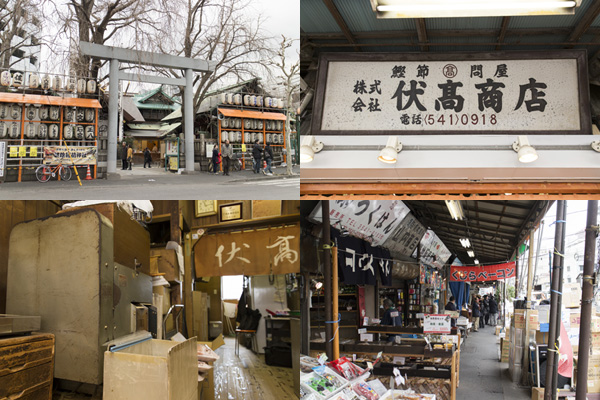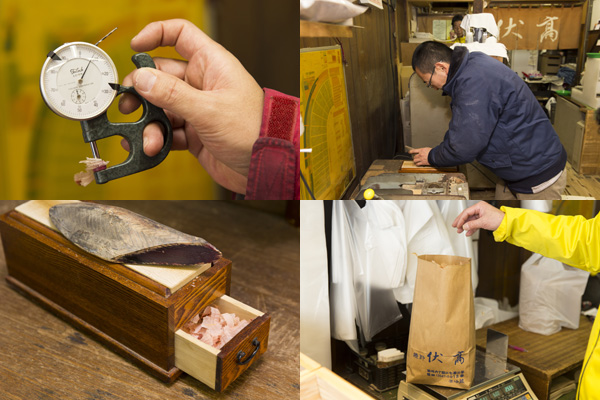Katsuobushi (dried bonito flakes): A Traditional Japanese Preserved Food
Feb 07,2014
Katsuobushi (dried bonito flakes): A Traditional Japanese Preserved Food
Feb 07,2014

Our ability to obtain fruits, vegetables, and seafood regardless of the season is a very recent phenomenon. Before modern refrigeration and transportation technologies, people had no choice but to eat what was available at the time.
People living in temperate regions, where fresh food is available throughout the year, can depend on seasonal produce alone. But in many parts of the world, due to climate or topography, it is hard to secure food for long periods during the year. This necessity drove people to develop preserves. A wide variety of techniques, such as fermenting, drying, or smoking perishable foodstuffs, are used to make preserves. Even today, many kinds of preserves are being formulated and produced all over the world.
This series is a journey that explores the mastery of preserves and the wisdom of everyday living, which form the foundation of food cultures. Part 6 covers katsuobushi — flakes of dried bonito — said to be the hardest food product in the world.
▶Hoshi-imo (Dried Sweet Potato): A Traditional Japanese Preserved Food
▶Tsukemono (Japanese pickles): A Traditional Japanese Preserved Food

Japanese cuisine — a vast array of a healthy food prepared with seasonal ingredients — has been added to the UNESCO Intangible Cultural Heritage List. But even as the world wakes up to value of Japanese cuisine, the humble katsuobushi, along with kelp and niboshi (small dried sardines), carries on as the key seasoning for our food culture. Frankly put, Japanese cuisine would not be complete without katsuobushi.
Fushitaka, located in Tsukiji, the kitchen of Tokyo, is a long-standing dried foods store established in 1918. Nakano Katsuhiko, the third-generation owner, spoke with us.
“By shaving katsuobushi and adding the flakes to hot water, you can make delicious soup in almost no time. Katsuobushi is an incredible instant food that we Japanese came up with. What people might not know is that it takes a tremendous amount of time to complete a single katsuobushi block. For example, a single honkarebushi block, which has been sprayed with mold multiple times, takes between six months and a year of hard work for an artisan to finish.”
All this time and effort, of course, boosts the price, but there is no shortage of professional chefs and ordinary consumers who demand the most authentic of ingredients.
“In the end, people are happier when they eat something that tastes great. [laughs]”
Removing virtually all moisture from the raw fish concentrates and locks in the natural umami in the rock-hard katsuobushi blocks. When the katsuobushi is shaved and the flakes reconstituted in hot water, the umami wells up in a wave of flavor and aroma. Katsuobushi truly is the ultimate instant food. Many of Fushitaka’s customers swear their cooking has improved just by using the brand’s dashi soup stock.


The photo on the left shows arabushi blocks, which have been exposed to open flames and smoke from hardwoods such as evergreen oak, common oak, and sawtooth oak to reduce the bonito’s moisture content. The smoke causes a thick layer of tar to build up on the surface. Arabushi is used to make the widely sold hanakatsuo (flower bonito flakes) packs.
The photo on the right shows honkarebushi blocks, which start as arabushi with the tar layer removed and then undergo three or four cycles of being sprayed with mold and then dried in the sun. At this point, the blocks have less than 15 percent moisture content and no further moisture can be extracted even if sprayed with mold again.
Compared to honkarebushi, arabushi has a more intense taste and aroma. You can tell the difference just by placing a single shaving flake in your mouth.
“Honkarebushi has a mellower taste and aroma. For me personally, I prefer the finished bushi [honkarebushi] when making dashi stock. But as a topping on rice or tofu, I think arabushi tastes better.”
Some hold that people in Eastern Japan prefer honkarebushi and people in Western Japan prefer arabushi. However, as taste is a matter of individual preference, blanket statements like these rarely hold true in practice.
Similarly, everyone has their own way of making dashi stock and how strong they like it to taste. Nakano taught us how to make dashi to bring out the natural flavor characteristics of the katsuobushi.
“Choose a pot with a wide opening so the hot water can circulate more easily. Once the water comes to a boil, reduce the heat to a low flame and put 80 grams of flakes into the pot per liter of water. Continue simmering for 30 seconds, then turn off the heat and strain the dashi when the flakes have settled to the bottom of the pot.”
Increase the simmering time if you want to make the flavor stronger. Beware though that the longer you let it simmer, the less aromatic the dashi becomes.
There are many other variations on dried fish flakes besides the differences between arabushi and honkarebushi. There are the thick flakes used by soba shops to make dashi for their sauces, dried tuna flakes and dried horse mackerel flakes, and katsuobushi made from dark flesh or light flesh and made from belly or back meat. Nakano will kindly advise you on the best katsuobushi for your preferences and needs.


We tried our hand at shaving katsuobushi. After watching Matsuda from the shop demonstrate the process, it was our turn. It wasn’t easy and our efforts seemed to only produce powder.
The trick is to steady the katsuobushi with both hands and shave while pushing downward on the block with the weight of your body. With Matsuda’s advice, I was finally able to shave off a small amount, but it was fairly strenuous work. I recalled my grandmother shaving katsuobushi in her kitchen long ago, and I now truly appreciate her dedication after all this time.
“Almost no one shaves katsuobushi anymore. Nearly everyone buys shaved katsuobushi because they come in sealed packages that prevent oxidation and keep them fresh.”
The katsuobushi used to make dashi stock is usually 0.06 to 0.07 millimeters thick. The katsuobushi sprinkled on okonomiyaki savory pancakes and other dishes is around 0.03 to 0.04 millimeters thick. This subtle difference affects the texture and taste.
People have been using katsuobushi for cooking stock since the Edo period (1603 to 1868). Let’s pass on this authentic taste and aroma, and the delight it engenders, to future generations. It’s up to us to preserve our intangible cultural heritage.
▶Hoshi-imo (Dried Sweet Potato): A Traditional Japanese Preserved Food
▶Tsukemono (Japanese pickles): A Traditional Japanese Preserved Food
